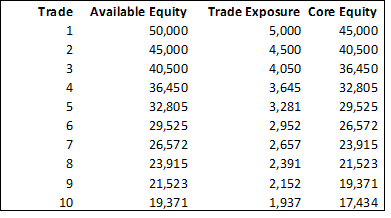12.1 –Defining Equity Capital
The last chapter we laid down few key thoughts on position sizing and with that, I guess it is amply clear as to why one has to incorporate position sizing at the core of every trading strategy. Position sizing technique helps you identify how much of your equity capital has to be exposed for a given trade. In this chapter, we will take that discussion forward and explore ways to position size.
A quick recap of sorts before we proceed. What is position sizing?
Position sizing is all about answering how much capital you will expose to a particular trade given that you have ‘x’ amount of trading capital. One classic position sizing strategy which most people employ is the standard 5% rule. The 5% rule does not permit you to risk more than 5% of the capital on a given trade. For example, if the capital is Rs.100,000/-, then they will not risk more Rs.5000/- on any single trade.
Here 5000 is the exposure to a trade and 10000 is the equity capital. You have decided to invest 5000 a trade based on a position sizing rule or a strategy.
Needless to say, there are many different ways to position size, which by the way, also means (unfortunately) that there is no single guided technique to position size. You as a trader need to experiment and figure out what works for you. Of course, I will discuss few position sizing techniques soon.
Now, irrespective of which position sizing technique you will follow, at some point the technique will require you to estimate your equity capital. For this reason, we will address the technique of estimating equity capital first and then proceed to learn position sizing techniques.
What do I mean by equity capital?
Equity capital is the basically the amount of money you have in your trading account based on which you decide how much capital to deploy in a trade. This may seem very trivial to you at this point. But allow me to illustrate why this is a tricky task.
Assume you have Rs.500,000 capital and you work with a simple position sizing principle of exposing not more than 10% capital to a single trade. Given this, assume you take a position worth Rs.50,000/-.
Now for the next trade, how much is your equity capital?
- Is it Rs.450,000?
- Is it still Rs.500,000 considering the fact 50K is deployed in a trade?
- Should it be 450,000 plus 50K ± the P&L from the trade that exists in the market?
Given that there are numerous outcomes and possibilities, estimating equity for the trade is not really a straightforward task. Hence, getting our act right in estimating the equity capital is very important before we proceed to learn position sizing concepts.

12.2 – Estimating Equity Capital
At this point, I’d like to go back to good old Van Tharp and talk to you some of the techniques he uses to estimate equity capital. These are some of the better techniques compared to the many out there. Essentially there are three techniques or models as he calls them –
- Core Equity model
- Total Equity model
- Reduced total equity model
The core equity model requires you to deduct the capital allocated to a trade from the existing capital. This way, the exposure to a trade goes on reducing as you ladder up more and more positions. Let me give you an example – assume your equity capital is Rs.50,000/- and you follow a simple 10% position sizing formula. The 10% rule implies that you do not expose or risk more than 10% of your capital to a trade. So the first trade gets an exposure of Rs.5000. The core equity is now reduced to Rs.45000. Have a look at the following table –
Download the excel sheet here.
So, the first trade assumes the equity available is Rs.50,000, hence 10% of the available equity is exposed first trade i.e Rs.5000/-. The core equity model requires you to deduct the capital deployed to a trade and re work on the core equity model. So, the core equity is now Rs.45000/-, which is also the available equity for the 2nd trade.
For the 2nd trade, we again deploy 10% of the equity available i.e 10% * 45000 = Rs.4500/-. We deduct this amount to calculate the new core equity, which is now Rs.40,500/-. This also is now the newly available equity for the 3rd trade.
So for the 3rd trade, the capital exposure for the trade is Rs.4050 and the new core equity is Rs.36,450/-. So on and so forth, I’m assuming you get the drift.
I consider this as a slightly conservative equity estimation model as you tend to reduce the capital allocation as the number of opportunities increases. For all you know, your 5th trade (for which the equity exposure is far lesser) may be a great winner. The other side of the argument is that the 5th trade could be the worst loser compared to the rest.
Having said that, I like this model for the sake of its simplicity. Once you commit the capital to a trade, you kind of forget about that and move on with what is available.
The Total equity model aggregates all the positions in the market along with its respective P&L and cash balance to estimate the equity. Let me straight away take an example to explain this –
Free cash available – Rs.50,000
Margin blocked for Trade 1 = Rs.75,000
P&L on Trade 1 = + Rs.2,000
Margin blocked for Trade 2 = Rs.115,000
P&L on Trade 2 = + Rs.7000
Margin blocked for Trade 3 = Rs.55,000
P&L on Trade 1 = – Rs.4,000
Total Equity = 50000 + 7000 + 2000 +115000+7500+55000-4000
= Rs.300,000/-
So, as you can see, in the total equity model, free cash along with margins blocked and the P&L per position is taken into consideration. Now, if my position sizing strategy suggests a 10% exposure to a new position, then I’d expose Rs.30,000/- on a new trade. If the free balance in my account does not permit me to take this position, then I’d not really initiate a new position. I’d wait to close one of the existing positions to take a new position.
The fact that this model considers a live position along with its P&L into account for estimating equity makes it a little risky. I’m personally not a big fan of this equity estimation model. This is somewhat like counting the chicken before they hatch.
I do like the 3rd model to estimate the equity, this one is called the ‘Reduced Total Equity Model’.
This model kind of combines the best of both the core equity model and the total equity model. It basically reduces the capital allocation to a particular trade (similar to core equity model) and at the same time includes the P&L of the trade which is already in place (similar to total equity model). However, the P&L is only on the locked in profits.
Let me work with an example to help you understand this better. Assume I have a capital of Rs.500,000/-. Further, assume my position sizing strategy allows me to invest not more than 20% on a single trade, which is Rs.100,000/- per trade.
I’m looking at the chart of ACC and I decide to go long on ACC futures at 1800 by blocking a margin of approximately Rs.90,000/-, which is well within my position sizing limit of Rs.100,000/-.
I’ve now entered a position and waiting for the market to move. Meanwhile, as per the reduced total equity model, my the capital available for the 2nd trade is –
20%*( 500,000 – 90,000)
= Or about 20% of Rs.410,000/-
= Rs. 82,000/-
Note, because of the existing position, the exposure capital has reduced from Rs.100,000 to Rs.82,000/-. Up to this point, it works exactly like the core equity capital model.
Now, assume the stock moves, and ACC jumps by 25 points to 1850. Considering the lot size of 400, I’m now sitting on a paper profit of –
400*50
= Rs.20,000/-
I would now put in a trailing stop loss and lock in at least about 25 points out of 50 point move or in Rupee terms, I want to lock in Rs.10,000 as profits.
This means, for the long ACC position at 1800, I have to now place a stop loss at 1825 and locked in Rs.10,000/- as profits.
I will now add this locked in profits back to the total equity. Hence my total equity now stands at –
410,000 +10,000
=420,000/-
This means, my new exposure capital will be 20% of the total equity –
=20% * 420000
= Rs.84,000/-
As you notice, the exposure capital has now increased by an additional 2000/-.
I kind of like the reduced total equity model to estimate the total capital available to position size. If one follows tends to follow this technique, then it kind of forces you to practice basic stop loss principles, which according to me is very good.
Anyway, I’d like to close this chapter at this point. In the next chapter, we will consider one of the above-stated methods to estimate equity and look into few position sizing technique.
Key takeaways from this chapter
- Estimating equity capital is crucial for position sizing
- Core equity model deducts the capital allocated to a trade and recalculate the capital available
- Total Equity model requires you to add the free cash, margins blocked, and the P&L of the positions to estimate the equity capital
- Reduced Total Equity model requires you to add the free cash to the locked in profits of an existing position



Hu karthik,
What i follow is 5% of total account size.
E.g i have 100000 than i take trade of 5000 Rs each. I.e total 20 trades.
Stoploss 3%, profit 6- 8%.
Whats your view on this?
In the next chapter, I would be talking about few more techniques 🙂
Sir, when the next module will be uploaded Ex- Financial modelling
The next module is on personal finance, maybe after this 🙂
Thanks for your patience and support!
how many more module is now left sir
Working on this module for now….plan is to include Personal finance (with a focus on MF), Trading strategies, and Financial Modelling.
The next module is on personal finance, maybe after this 🙂
Thanks for your patience and support!
Module 10 >..< ?? ?? ??
After Module 9.
Hi Sir,
Plz make module on tracking fii investment stocks.
How to track which stocks they are buying these day.
Thanks
Thanks for the suggestion. Will try and put up a chapter on that sometime soon.
And yes
HAPPY INDEPENDENCE DAY.
Thanks, Sohail. Wishing you the same!
can you educate us on index ETF, INVERSE ETFS AND Gold ETF?
The next module is in personal finance. Will include this in that module.